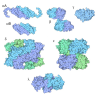+ Open data
Open data
- Basic information
Basic information
| Entry | Database: PDB / ID: 8s7a | ||||||
|---|---|---|---|---|---|---|---|
| Title | HSPB8acd-C99S/F155T/A156S | ||||||
 Components Components | Heat shock protein beta-8 | ||||||
 Keywords Keywords | CHAPERONE / apo | ||||||
| Function / homology |  Function and homology information Function and homology informationpositive regulation of aggrephagy / protein folding chaperone complex / cellular response to unfolded protein / HSF1-dependent transactivation / protein homodimerization activity / nucleoplasm / identical protein binding / nucleus / cytoplasm / cytosol Similarity search - Function | ||||||
| Biological species |  Homo sapiens (human) Homo sapiens (human) | ||||||
| Method |  X-RAY DIFFRACTION / X-RAY DIFFRACTION /  SYNCHROTRON / SYNCHROTRON /  MOLECULAR REPLACEMENT / Resolution: 1.951 Å MOLECULAR REPLACEMENT / Resolution: 1.951 Å | ||||||
 Authors Authors | Wang, Z. / Benesch, J. | ||||||
| Funding support |  United Kingdom, 1items United Kingdom, 1items
| ||||||
 Citation Citation |  Journal: To Be Published Journal: To Be PublishedTitle: HSPB8acd C99S/F155T/A156S Authors: Wang, Z. / Benesch, J. | ||||||
| History |
|
- Structure visualization
Structure visualization
| Structure viewer | Molecule:  Molmil Molmil Jmol/JSmol Jmol/JSmol |
|---|
- Downloads & links
Downloads & links
- Download
Download
| PDBx/mmCIF format |  8s7a.cif.gz 8s7a.cif.gz | 29.6 KB | Display |  PDBx/mmCIF format PDBx/mmCIF format |
|---|---|---|---|---|
| PDB format |  pdb8s7a.ent.gz pdb8s7a.ent.gz | 17.4 KB | Display |  PDB format PDB format |
| PDBx/mmJSON format |  8s7a.json.gz 8s7a.json.gz | Tree view |  PDBx/mmJSON format PDBx/mmJSON format | |
| Others |  Other downloads Other downloads |
-Validation report
| Summary document |  8s7a_validation.pdf.gz 8s7a_validation.pdf.gz | 450 KB | Display |  wwPDB validaton report wwPDB validaton report |
|---|---|---|---|---|
| Full document |  8s7a_full_validation.pdf.gz 8s7a_full_validation.pdf.gz | 450.9 KB | Display | |
| Data in XML |  8s7a_validation.xml.gz 8s7a_validation.xml.gz | 5.6 KB | Display | |
| Data in CIF |  8s7a_validation.cif.gz 8s7a_validation.cif.gz | 6.6 KB | Display | |
| Arichive directory |  https://data.pdbj.org/pub/pdb/validation_reports/s7/8s7a https://data.pdbj.org/pub/pdb/validation_reports/s7/8s7a ftp://data.pdbj.org/pub/pdb/validation_reports/s7/8s7a ftp://data.pdbj.org/pub/pdb/validation_reports/s7/8s7a | HTTPS FTP |
-Related structure data
| Similar structure data | Similarity search - Function & homology  F&H Search F&H Search |
|---|
- Links
Links
- Assembly
Assembly
| Deposited unit | 
| ||||||||
|---|---|---|---|---|---|---|---|---|---|
| 1 | 
| ||||||||
| Unit cell |
|
- Components
Components
| #1: Protein | Mass: 9140.352 Da / Num. of mol.: 1 Source method: isolated from a genetically manipulated source Source: (gene. exp.)  Homo sapiens (human) / Gene: HSPB8, CRYAC, E2IG1, HSP22, PP1629 / Production host: Homo sapiens (human) / Gene: HSPB8, CRYAC, E2IG1, HSP22, PP1629 / Production host:  |
|---|---|
| #2: Chemical | ChemComp-SO4 / |
| #3: Chemical | ChemComp-GOL / |
| #4: Water | ChemComp-HOH / |
| Has ligand of interest | N |
| Has protein modification | N |
-Experimental details
-Experiment
| Experiment | Method:  X-RAY DIFFRACTION / Number of used crystals: 1 X-RAY DIFFRACTION / Number of used crystals: 1 |
|---|
- Sample preparation
Sample preparation
| Crystal | Density Matthews: 2.84 Å3/Da / Density % sol: 56.64 % |
|---|---|
| Crystal grow | Temperature: 295 K / Method: vapor diffusion, sitting drop Details: 0.2 M lithium sulfate monohydrate 0.1 M Tris pH 8.5 1.26 M ammonium sulfate |
-Data collection
| Diffraction | Mean temperature: 100 K / Serial crystal experiment: N |
|---|---|
| Diffraction source | Source:  SYNCHROTRON / Site: SYNCHROTRON / Site:  Diamond Diamond  / Beamline: I04 / Wavelength: 0.9795 Å / Beamline: I04 / Wavelength: 0.9795 Å |
| Detector | Type: DECTRIS EIGER X 16M / Detector: PIXEL / Date: Oct 18, 2022 |
| Radiation | Monochromator: synchrotron / Protocol: SINGLE WAVELENGTH / Monochromatic (M) / Laue (L): M / Scattering type: x-ray |
| Radiation wavelength | Wavelength: 0.9795 Å / Relative weight: 1 |
| Reflection | Resolution: 1.95→34.745 Å / Num. obs: 7957 / % possible obs: 100 % / Redundancy: 13.1 % / CC1/2: 1 / Rmerge(I) obs: 0.054 / Net I/σ(I): 19.6 |
| Reflection shell | Resolution: 1.95→5.29 Å / Redundancy: 13.6 % / Rmerge(I) obs: 4.188 / Mean I/σ(I) obs: 0.3 / Num. unique obs: 389 / CC1/2: 0.285 / % possible all: 100 |
- Processing
Processing
| Software |
| ||||||||||||||||||||||||||||
|---|---|---|---|---|---|---|---|---|---|---|---|---|---|---|---|---|---|---|---|---|---|---|---|---|---|---|---|---|---|
| Refinement | Method to determine structure:  MOLECULAR REPLACEMENT / Resolution: 1.951→34.745 Å / SU ML: 0.26 / Cross valid method: FREE R-VALUE / σ(F): 1.34 / Phase error: 44.38 / Stereochemistry target values: ML MOLECULAR REPLACEMENT / Resolution: 1.951→34.745 Å / SU ML: 0.26 / Cross valid method: FREE R-VALUE / σ(F): 1.34 / Phase error: 44.38 / Stereochemistry target values: ML
| ||||||||||||||||||||||||||||
| Solvent computation | Shrinkage radii: 0.9 Å / VDW probe radii: 1.11 Å / Solvent model: FLAT BULK SOLVENT MODEL | ||||||||||||||||||||||||||||
| Refinement step | Cycle: LAST / Resolution: 1.951→34.745 Å
| ||||||||||||||||||||||||||||
| Refine LS restraints |
| ||||||||||||||||||||||||||||
| LS refinement shell |
|
 Movie
Movie Controller
Controller



 PDBj
PDBj







